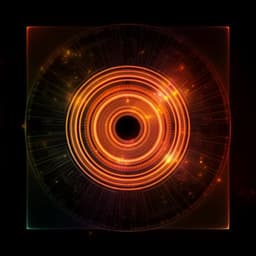
Physics
Observation of Josephson harmonics in tunnel junctions
D. Willsch, D. Rieger, et al.
This paper explores the limitations of the standard current-phase relation in transmon artificial atoms, revealing how including higher Josephson harmonics drastically improves alignment with experimental findings. Conducted by a team of experts, the research is pivotal for advancing AlOx-based quantum technologies.
~3 min • Beginner • English
Introduction
The work investigates whether the commonly assumed sinusoidal current–phase relation (CPR) for Al–AlOx–Al tunnel Josephson junctions is sufficient to model superconducting qubits. Although tunnel junctions contain many conduction channels, the standard model reduces them to a single critical current parameter with I(φ)=Ic sinφ. Non-tunnel junctions are known to exhibit higher Josephson harmonics, and the authors question if similar harmonics are present and relevant in tunnel junctions. Considering microscopic inhomogeneities (contaminants, defects, grain orientations) in AlOx barriers, they hypothesize that a distribution of channel transparencies—including a few relatively high-transparency channels—induces measurable higher-harmonic terms in the CPR. The goal is to test and quantify these harmonics by comparing measured transmon spectra to models with and without Josephson harmonics and to assess implications for qubit performance, especially charge dispersion and anharmonicity.
Literature Review
Background establishes the Josephson effect as central to superconducting quantum technologies and highlights that non-sinusoidal CPRs with higher harmonics are well documented in weak links, point contacts, ferromagnetic junctions, and semiconductor-based elements. Standard modeling for tunnel junctions uses a sinusoidal CPR, which emerges in the limit of very low channel transparencies. However, prior microscopy and simulations point to AlOx barrier inhomogeneity and thickness variations, motivating the expectation of a transparency distribution and possible higher-transparency channels. References to prior work include theory of CPR in various junctions, observations of higher-harmonic CPR components, and fabrication/structure studies of AlOx barriers, as well as methodologies for spectral reconstruction used in hybrid Josephson elements. This context supports revisiting tunnel-junction CPR models and incorporating higher harmonics for accurate circuit descriptions.
Methodology
- Devices and samples: Transmon devices based on standard Al–AlOx–Al tunnel junctions measured across multiple laboratories: KIT (fixed-frequency transmons measured over three cooldowns, CD1–CD3), ENS Paris (device as in prior work), University of Cologne (tunable transmon with in-plane magnetic field), and 20 qubits from IBM Hanoi. Architectures include 3D and 2D coplanar waveguide implementations.
- Measurements: Circuit QED spectroscopy of: (1) transition frequencies f0j for j=1…6, measured as j-photon transitions; (2) resonator frequencies fres dependent on transmon state j=0,1. For the Cologne device, offset-charge dispersion versus magnetic field is measured, with EJ tuned via an in-plane magnetic field up to 0.4 T (suppressing EJ by up to 35%).
- Standard model: Exact diagonalization of Hstd=4EC(n−ng)^2−EJ cosφ+Hres, with Hres=ωr a†a+G(a†+a), fitting parameters (EC, EJ, ωr, G) via an inverse eigenvalue problem (IEP) using spectroscopic data (including charge-dispersion data for the Cologne sample). This includes dressing from transmon–resonator hybridization.
- Josephson harmonics model: Exact diagonalization of the extended Hamiltonian Hhar=4EC(n−ng)^2−∑m≥1 Em cos(mφ)+Hres. Two implementations: (1) a phenomenological model truncated at EJ4 (and in some scans up to EJ10 to ensure physicality and assess truncation); (2) a mesoscopic tunnelling model through a non-uniform oxide barrier. In the mesoscopic model, a Gaussian barrier thickness distribution with mean d and standard deviation σ induces a transparency distribution p(T;d,σ); harmonics are computed via EJm(d,σ)∝∫0∞ cm(T) p(T;d,σ) dT, where cm(T) are Fourier coefficients of single-channel CPRs. Thus all m≥2 harmonics are determined by two parameters (d,σ), while EJ is varied to match f01 under field.
- Data analysis: Compare measured transition frequencies to model predictions, quantify deviations, and extract ranges of |EJm/EJ| consistent with spectra. Evaluate charge dispersion δf versus fJ (=f01) and compare predictions of standard vs harmonics models with fixed EJm/EJ ratios while tuning EJ with magnetic field.
- Microscopy and simulation: High-angle annular dark-field STEM imaging of AlOx barriers and molecular dynamics simulations provide independent estimates of barrier thickness and inhomogeneity, informing d and σ used in the mesoscopic model.
- Controls and corrections: Consider potential alternative effects including stray inductance, hidden modes, inter-qubit couplings (IBM device), and superconducting gap asymmetry; these do not account for observed discrepancies fully. Measurement imprecision is ~1 MHz.
Key Findings
- The standard transmon model (sinusoidal CPR) fails to reproduce measured spectra across all samples, with discrepancies far exceeding measurement imprecision (~1 MHz). Deviations in f01 can exceed 10 MHz, and systematic deviations grow with higher levels (up to j=6).
- Incorporating Josephson harmonics yields orders-of-magnitude better agreement with measured spectra for all samples. A phenomenological truncation up to m=4 or m≤10 fits well; a mesoscopic model based on an inhomogeneous AlOx barrier (Gaussian thickness distribution) accurately describes KIT, ENS, and Cologne data.
- Percent-level higher-harmonic content is ubiquitous. The second-harmonic amplitude |EJ2/EJ| is consistently in the few-percent range. Even the most homogeneous KIT barrier (CD3) has |EJ2/EJ|=2.4%, implying at least one conduction channel with transparency τ≥0.29.
- Mesoscopic model parameterization by barrier mean thickness d and standard deviation σ yields physically plausible values consistent with STEM and molecular dynamics; it does not fully capture IBM device behavior, indicating stronger or different sources of harmonics there.
- Charge-dispersion impact: For the Cologne device, the standard model underestimates charge dispersion by factors of 2–7 for j=1–3 over fJ≈3.5–6 GHz as EJ is reduced by up to 35% with B⊥≤0.4 T. The harmonics model reproduces the measured dispersion across the sweep.
- In IBM Hanoi qubits, large harmonics can reduce qubit charge dispersion by up to roughly an order of magnitude relative to standard-model expectations (observed reduction up to ~4× for qubits 0–2), indicating potential for engineered harmonics to decrease charge-noise decoherence while preserving or enhancing anharmonicity.
- Surveyed ranges of |EJm/EJ| across samples lie between physical limits set by a homogeneous low-transparency barrier and a fully open quantum point contact (τ=1).
Discussion
The results demonstrate that the simplistic sinusoidal CPR is insufficient to model AlOx tunnel junctions in transmon circuits. Spectral discrepancies are directly attributable to higher-order Josephson harmonics arising from barrier inhomogeneities and a distribution of conduction channel transparencies, including relatively high-transparency channels (T>10−1). Introducing harmonics into the Hamiltonian resolves the mismatch between theory and experiment across disparate devices and measurement conditions, validating the physical picture that microscopic barrier structure imprints itself on the CPR. The harmonics significantly affect higher excited levels and the charge dispersion, a key decoherence channel, thereby influencing qubit performance, calibration, and control. The mesoscopic model links measurable spectral features to barrier statistics (d,σ), offering a device-agnostic metrology for barrier uniformity. The observation that engineered harmonics can reduce charge dispersion and maintain anharmonicity suggests design strategies—via transparency shaping or added inductance—to optimize qubits for reduced charge noise and improved operation, with broader implications for circuit-QED devices, amplifiers, and metrological standards.
Conclusion
This work establishes that AlOx tunnel junctions exhibit measurable higher Josephson harmonics that must be included to accurately model transmon spectra and charge dispersion. A harmonics-augmented Hamiltonian achieves orders-of-magnitude better agreement with measurements, with the second harmonic at the few-percent level across samples. A mesoscopic model connecting barrier thickness inhomogeneity to harmonic content quantitatively explains multiple devices and provides a route to characterize tunnel barriers via spectroscopy. These insights impact the design and modeling of superconducting quantum circuits, parametric devices, and metrological elements. Future directions include: (1) developing fabrication processes for more uniform, low-transparency barriers to suppress unwanted harmonics; (2) engineering CPRs (e.g., controlled transparency distributions or series inductance) to exploit beneficial harmonics for reduced charge dispersion and enhanced anharmonicity; (3) extending the framework to topological JJ circuits, parametric pumping schemes, and protected qubits; and (4) refining mesoscopic models to capture devices with extreme harmonics (e.g., some IBM qubits).
Limitations
- The mesoscopic Gaussian-thickness model fits KIT, ENS, and Cologne data but does not fully account for IBM device spectra, indicating limitations in the assumed transparency distribution or additional circuit-specific effects.
- While alternative corrections (series inductance, hidden modes, inter-qubit coupling on multi-qubit chips, superconducting gap asymmetry) were evaluated, they cannot on their own explain the discrepancies; residual contributions from these mechanisms may still be present.
- Extraction of EJm involves model assumptions and potential multiplicity in inverse eigenvalue solutions; finite truncation in harmonics (m≤4–10) may overlook very high-order terms.
- Measurement precision (~1 MHz) is much smaller than observed deviations, but device-to-device variability and ageing/annealing effects (as seen across KIT cooldowns) introduce additional uncertainties.
- Microscopy and molecular dynamics inform barrier parameters but may not capture all fabrication-induced inhomogeneities or disorder types relevant for transparency distributions.
Related Publications
Explore these studies to deepen your understanding of the subject.







